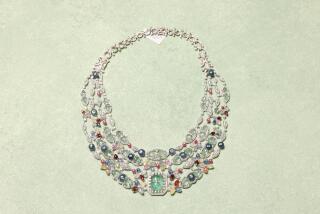INVESTMENT OUTLOOK : BEYOND THE TRADITIONAL : Finding Gold in Coins, Cars and Collectibles : Trustworthy Advice Is Critical in Selecting the Right Tangible Assets
Andrew Johnston, director of stamps and coins for San Francisco-based Butterfield & Butterfield auction house, moved his expert eye over 60 gold coins that U.S. marshals had brought for his appraisal.
The marshals had seized the coins from a Southern California drug dealer.
The coins were gold, all right, Johnston concluded. Gold-plated.
He recalled the story recently to illustrate the main problem in investing in tangibles: establishing whom you can trust.
Coins, stamps, bullion, gems, cars and other collectibles have long provided opportunities for unscrupulous dealers to fleece the unwary, including other dealers. But, despite the risks, experts say they expect investors to continue to rely on these investments as a way of diversifying their portfolios and hedging against inflation.
The coin market in particular is expected to expand rapidly. It has revolutionized itself in the last three years by designating a handful of experts whom most coin dealers have agreed that you--and they--can trust.
These experts grade the all-important condition of coins and seal the graded coins in plastic. The coins can then be traded as commodities.
“Before this,” Johnston said, “one dealer would look at a coin and say it’s ‘extra fine.’ . . . But some other dealer might not feel the same way.”
Standardized grading has allowed rare U.S. coins to be traded sight-unseen via an exchange.
It has also produced the entry of Wall Street into the coin field.
“In the (traditional) rare coin market, you had to be an expert to know how to achieve (good) returns,” said Hugh Sconyers, manager of the American Rare Coin Fund, a Kidder, Peabody & Co. limited partnership. “Now the industry has taken a good bit of the subjectivity away.”
Although the rare coin market remains volatile, Sconyers said grading has eased the occasional inability of owners wanting to sell. “We see active bids and offers on 12,000 coins every day,” he said.
Other Wall Street firms are rumored to be considering joining Kidder Peabody in the coin field. Shearson Lehman Hutton acknowledges that it may.
Wall Street firms, as well as local dealers, offer ways to play the precious metals market.
Experts said they believe that platinum is likely to outpace gold and silver as an investment in the next decade, mainly because of supply and demand.
Platinum is 15 times more scarce than gold and much in demand by industry, particularly for the catalytic converters used in cars for pollution control.
The price of platinum--like that of other precious metals--has been volatile in recent years. It hit a low of $240 an ounce in 1985, soared to about $750 two years later, and recently was selling at about $500.
By comparison, gold hit $800 an ounce in 1980, dropped to $290 two years later, rallied to $500 in 1985 and was recently at about $400.
Silver, which traded at $50 an ounce in 1980, recently was trading at a little more than $5.50
“Metals tend to run together in terms of up moves,” said Barry S. Stuppler, president of the California Coin & Precious Metals Assn. “But I think platinum will lead the market.”
Other experts agreed, but warned that the situation could change if a sudden breakthrough in automotive pollution controls negated the need for platinum, or supply dried up because of political problems with the world’s principal producers, the Soviet Union and South Africa.
As with any investment, there is uncertainty. That leads experts to recommend investing in tangibles only if you are very knowledgeable or like what you’re buying.
That’s the strategy that Bob Hall, associate editor of Old Cars Weekly, advocates when it comes to buying cars.
“I don’t know if I’d recommend (investing in cars),” Hall said. “I think most people would say, ‘Don’t make any car investments unless you like the car.’ ”
Nonetheless, Hall identified certain types of cars that are hot--”almost anything the top will come down on,” and “muscle cars,” such as Dodge Chargers and SS396 Chevrolet Chevelles that rolled off the assembly lines in the late 1960s and early 1970s with high-horsepower engines.
“The prices for those have really skyrocketed,” Hall said, “although how long that trend will last, who knows? A ’71 Dodge Challenger . . . with low mileage . . . recently sold for $81,000. . . . It wasn’t even a convertible.”
Ben Horowitz, founding president of the Art Dealers Assn. of California, also disputed the notion that you can invest in tangibles, particularly art.
“It’s almost like an ‘investment’ in Holland bulbs. Art should be bought for aesthetic values,” he said. “The fact that art goes up (in cost) over the years--that is, good art--is a normal thing.”
What is abnormal, he said, is the “frenzy in purchasing art by people who basically do not care anything about the art.” That has led to record auction prices and more wealthy contemporary artists than at any time in history.
Partly because of the high price of fine arts, middle-class investors have transformed the world of collectibles.
“When you say ‘collectibles’ today, you have opened a Pandora’s box,” said Tony Hyman, author of a collectors’ directory. “At one time it was possible to talk about guns, coins, dolls, toys and maybe a smattering of other things, and you would have defined the world of collectibles.
“But today, with inflation . . . my God, we’ve seen dolls go over $40,000--we’ve seen the middle-class collector turning more and more to lower-priced goods.”
These range from cigar boxes to tin cans that can sell for thousands of dollars, Hyman said.
Some undervalued items today, he said, are Mexican folk art, neon art, Richard Nixon memorabilia and personal computer catalogues and repair manuals from the 1970s.
“In 2020, when computer illiteracy is unthinkable,” Hyman said, “that stuff is going to be so hotly sought it is going to be a mindblower.”
More to Read
Inside the business of entertainment
The Wide Shot brings you news, analysis and insights on everything from streaming wars to production — and what it all means for the future.
You may occasionally receive promotional content from the Los Angeles Times.










